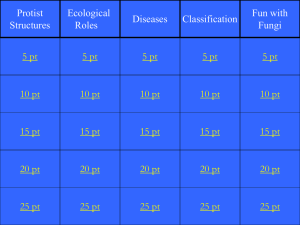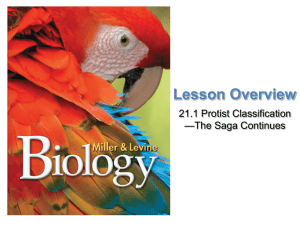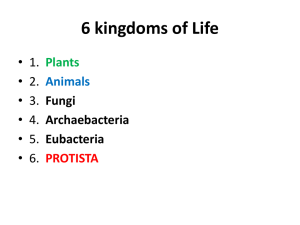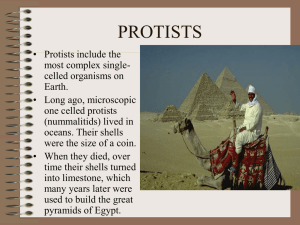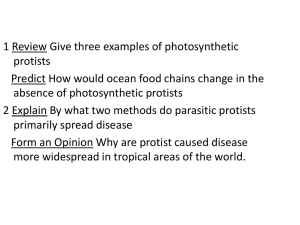Protist PowerPoint
advertisement
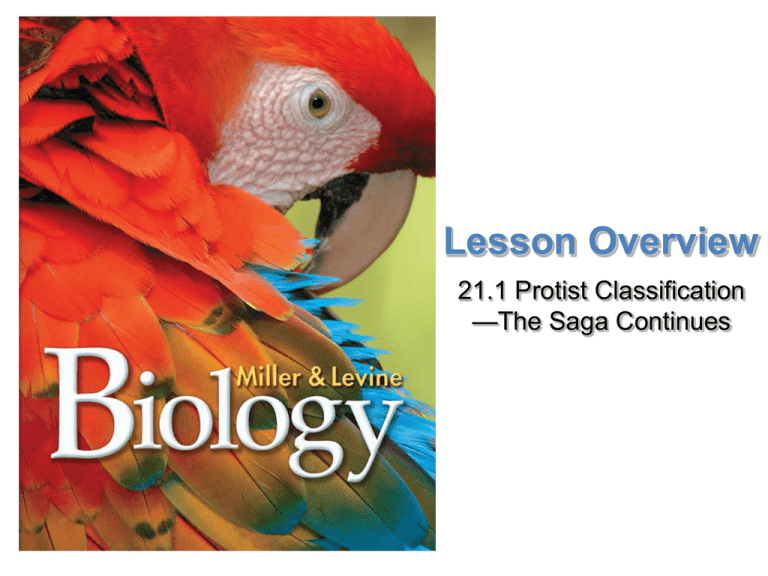
Lesson Overview Protist Classification—The Saga Continues Lesson Overview 21.1 Protist Classification —The Saga Continues Lesson Overview Protist Classification—The Saga Continues The First Eukaryotes Protists are eukaryotes that are not members of the plant, animal, or fungi kingdoms. Although most protists are unicellular, quite a few are not. Lesson Overview Protist Classification—The Saga Continues The “Protist” Dilemma Biologists have discovered that “protists” display a far greater degree of diversity than any other eukaryotic kingdom. Euglena, brown algae, diatoms, and slime molds are examples of protists. Biologists also found that many “protists” are far more closely related to members of other eukaryotic kingdoms than they are to other “protists.” Lesson Overview Protist Classification—The Saga Continues Multiple Kingdoms? Lesson Overview Protist Classification—The Saga Continues What “Protist” Means Today Even though the biologist building the Tree of Life prefer a different classification, the word “protist” remains in common usage, even among scientists. Bear in mind that “protists” are not a single kingdom but a collection of organisms that includes several distinct clades. Lesson Overview Protist Classification—The Saga Continues Protists—Ancestors and Descendants The split between Archaea and Eukarya may have come as early as 2.5 billion years ago. Since that time, protists have diversified into as many as 300,000 species. Lesson Overview Protist Classification—The Saga Continues Protists—Ancestors and Descendants The roots of all eukaryotic diversity, from plants to animals, are found among the ancestors of protists. Lesson Overview Protist Classification—The Saga Continues Amoeboid Movement Many unicellular protists move by changing their shape, a process that makes use of cytoplasmic projections known as pseudopods. Amoeboid movement is powered by a cytoskeletal protein called actin. Actin also plays a role in the muscle contractions of animals. Lesson Overview Protist Classification—The Saga Continues Cilia and Flagella Many protists move by means of cilia and flagella, structures supported by microtubules. Cilia are short and numerous, and they move somewhat like oars on a boat. Flagella are relatively long and usually number only one or two per cell. Some flagella spin like tiny propellers, but most produce a wavelike motion from base to tip. Lesson Overview Protist Classification—The Saga Continues Passive Movement Some protists are nonmotile—they depend on air or water currents and other organisms to carry them around. These protists form reproductive cells called spores that can enter the cells of other organisms and live as parasites. Lesson Overview Protist Classification—The Saga Continues Conjugation Paramecia and most ciliates reproduce asexually by mitotic cell division. However, under stress, paramecia can remake themselves through conjugation—a process in which two organisms exchange genetic material. Lesson Overview Protist Classification—The Saga Continues Conjugation Paramecium has two types of nuclei: a macronucleus and one or more smaller micronuclei. The micronucleus holds a “reserve copy” of every gene in the cell. The macronucleus has multiple copies of the genes the cell uses in its day-to-day activities. Lesson Overview Protist Classification—The Saga Continues Conjugation Lesson Overview Protist Classification—The Saga Continues Conjugation Lesson Overview Protist Classification—The Saga Continues Conjugation Lesson Overview Protist Classification—The Saga Continues Conjugation Lesson Overview Protist Classification—The Saga Continues Conjugation Lesson Overview Protist Classification—The Saga Continues Conjugation Lesson Overview Protist Classification—The Saga Continues Conjugation Lesson Overview Protist Classification—The Saga Continues Sexual Reproduction Many protists have complex sexual life cycles in which they alternate between a diploid and a haploid phase, a process known as alternation of generations. Lesson Overview Protist Classification—The Saga Continues Sexual Reproduction Water molds reproduce asexually by producing spores in a structure called a sporangium. The male and female structures produce haploid nuclei that fuse during fertilization, forming a zygote that begins a new life cycle.

